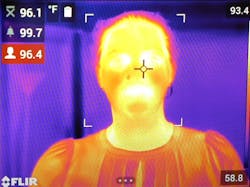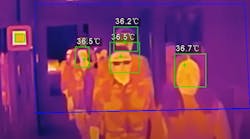Tech Trends: Thermal Temperature Scanning Lessons Learned
It feels like a lifetime ago when I wrote my May 2020 column about various security technologies that had been introduced or newly marketed as tools in helping to manage the global pandemic. The security industry has always done a remarkable job of innovating during tough times and in response to evolving threats to our normal way of life; that being said, as a consultant and designer, the difficultly has always been in interpreting the validity of these solutions and ensuring they are being deployed effectively.
Perhaps the most widely marketed solution over the past many months has been the thermographic (thermal) camera. On its surface, the value is obvious – instant detection of elevated body temperatures over a large or fast-moving group of people. In practice, however, this solution needs to be heavily caveated.
I teamed up with my colleague Joe Fallon, Security Solutions Manager at the Faith Group, to help articulate some of the shortcomings of the technology and how to best manage expectations for its use. Joe’s work has brought him to the forefront of thermographic technology, running rigorous testing programs at several international airports. He has tested dozens of camera types spanning both established and startup technology firms. Joe’s experience has been consistent with my own research within the multi-tenant commercial environment.
Concepts of Operation (ConOps)
Joe and I are in strong agreement when it comes to the most important ingredient for success in thermographic deployment – ensuring the ConOps are developed first, and then the right technology is designed to support those use cases.
“Thermographic sensors are no different than any other video surveillance sensor, and just like there are various cameras – each of which is suited for very different use-cases – there are various types of thermographic sensors with equally varying strengths and weaknesses,” Fallon explains. “The first and by far the most critical step in a successful implementation is having the client’s ConOps and associated use-cases for the system well documented and vetted with local stakeholders. When this information is thoroughly understood, then the proper thermographic sensor can be chosen and deployed based on its specific design constraints.”
Fallon’s work has fleshed out a number of additional important factors with thermographic technology. As one might expect, there is no one product that does everything perfectly well; instead, the best way choose a technology is to understand which attributes are most important to a particular operation. For example, is precision or accuracy more important to a deployment? Distance to target or viewing angle? Knowing how the camera will be deployed first will help dictate the technology used.
Know the Shortcomings and Capabilities
If you were to ask either of us what the best thermographic camera on the market is today, we would undoubtedly respond with: What are you using it for?
“It is important for the clients to understand that there is no silver bullet, and all of the systems available today have strengths and weaknesses,” Fallon says. “Managing these expectations up front, followed by a traditional design approach to include ConOps development, factory acceptance testing, pilot deployment, and final system testing and commissioning will ensure that when completed, the client will have a system that fulfills their developed use-cases and meets their overall expectations.”
Fallon’s detailed work in the field has produced an incredible amount of useful data, with some important insights for anyone looking at thermographic deployment:
- The maximum distance to target is around 25 feet for any sort of accurate thermal reading.
- Most high-end thermal cameras quote an accuracy of around +/- .2 degrees. Higher-end cameras tend to have reasonably good precision: some generally read high, and others typically read low, but that range is often narrow.
- Accuracy and precision are both impacted by how the thermal camera reads temperature. Some cameras look for the hottest point on someone’s body and report that value as the body temperature. This method is somewhat prone to shifts in ambient temperature or whether the person was exerting themselves. More advanced units use analytics to find and measure temperature at the tear ducts, which is a more accurate representation of the individual’s true body temperature.
- Accuracy and precision are increased when thermal cameras use a blackbody radiator. A blackbody is a device which outputs a constant thermal reference point and is placed in the camera’s field of view. The camera is then able to constantly calibrate itself in real time based on the known thermal value in its view.
- The viewing angle between the camera and its target impacts a camera’s ability to get an accurate reading. The maximum viewing angle should be no greater than 20 degrees.
- The characteristics of the deployment environment matter. Areas with high thermal noise, such as in front of a large exterior pane of glass, suffer greatly from reduced accuracy.
- Even under ideal conditions noted above, the best accuracy (true positives and true negatives) achievable is somewhere around 70%.
Understand Legal and Privacy Concerns
What happens when someone is flagged as having an elevated body temperature? Are they being called out and potentially embarrassed in front of a crowded office lobby, and does that violate HIPAA? Is that person removed from queue and sent to secondary screening by a medical professional? Are they refused entry to a facility based on the results of a thermographic sensor? If they are mistakenly refused entry and miss a flight or an important meeting, is the facility operator liable for damages?
These are baseline questions that should be answered before anyone places a PO for a single piece of thermographic equipment, and I strongly recommend engaging counsel so that any end-user has understood and acknowledged what the risks may be.
Despite some of the shortcomings, Fallon believes the technology will be a mainstay of the security industry for the foreseeable future. “Global pandemics are not new, and the frequency and severity of these pandemics has steadily increased over time,” he says. “As a result, it is imperative to implement screening systems to ensure critical infrastructure and other employers can provide a healthy environment for their employees – thus ensuring continuity of operations and protecting global economies. The technology will continue to improve.”
Brian Coulombe ([email protected]) is Principal and Director of Operations at Ross & Baruzzini | DVS. Connect with him on Linkedin at www.linkedin.com/in/brian-coulombe or Twitter, @DVS_RB.




